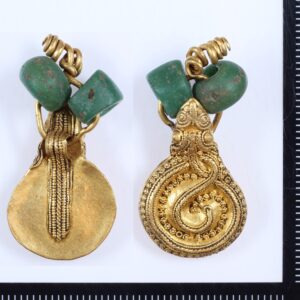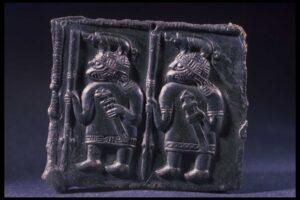Certain animals in Viking Age Scandinavia were linked with good luck, magical powers, and human spirituality.
| “Freyr’s messenger, down into the world of black-elves to some dwarfs and had a fetter called Gleipnir made. It was made of six ingredients: the sound of a cat’s footfall and the woman’s beard, the mountain’s roots and the bear’s sinews and the fish’s breath and bird’s spittle.”
Gylfaginning, 34 |
Again in Gylfaginning, the first part of the Prose Edda written in 1220 CE by Snori Sturluson in Iceland, the recipe for a magical strong fetter to hold back a wolf is described to contain cat, bear, fish, and bird. These animals are seen throughout other texts as being considered magical or lucky as well. |
 Pendant from Gørding, DK. |
This coiled snake pendant with a gold filigree decoration was found in southwest Jutland, Denmark. It is thought to have the purpose of providing protective powers. |
| “They disembark as soon as their boats dock. Each carries bread, meat, onions, milk, and alcohol to a large block of wood set in the ground. {…} Then he says ‘And I have brought this offering.’ He leaves his offering in front of the piece of wood, saying, ‘I want you to bless me with a rich merchant with many dinars and dirhams who will buy from me whatever I wish and not haggle over any price I set.’”
Ibn Fadlan, 77 |
Ahmad ibn Fadlan was a Muslim traveler who wrote various ethnographic accounts of communities during the 10th century CE, including one account on Volga Viking trading and a funeral ceremony that he had witnessed first-hand. This account describes the use of animal meat as good luck offerings to the gods, as well as later mentioned cattle and sheep offerings for the best chance at positive merchant business. |
| “‘When you came into the main room, a polar bear cub followed you and ran on ahead into the room. But when he saw me, he stopped and you were going along in a rush and fell over the cub and it is my belief that you are not the son of Krum or of Thorgunna but instead are of a greater family.’”
The Tale of Thorstein Bull’s-Leg, 5 |
The story of Thorstein Oddnyarson in The Tale of Thorstein Bull’s-Leg describes the life of a hero and the obstacles he had to face. This quote describes a polar bear cub following Thorstein due to his unknown power and high family rank, as well as his lucky, and almost magical, successes throughout the saga. |
 Helmet Plate, Torslunda, SE. |
Current literature has also evaluated the role of animal imagery in body fluidity during the Viking Age. Hedeager describes this as the existence of a spiritual world of humans and animals and humans manifested as animals, with animals playing a big role in shaping Old Norse religion as they conveyed their knowledge of nature to humans and gods. As seen in the image, there was a lot of Viking Age art showing crossovers between warriors and wild boars. |
Graham-Campbell, James. Viking Art. 3rd ed. London: Thames and Hudson, 2021.
Hedeager, Lotte. “Split Bodies in the Late Iron Age/Viking Age of Scandinavia.” In Body Parts and Bodies Whole – Changing Relations and Meaning, edited by Katharina Rebay-Salisbury, Marie Louise Stig Sørensen, and Jessica Hughes, 111–18. Oxford: Oxbow Books, 2010.
Hreinsson, Viđar, ed. “The Tale of Thorstein Bull’s-Leg (Þorsteins þáttr uxafóts).” In The Complete Sagas of Icelanders Including 49 Tales, 4:340–54. Reykjavík: Leifur Eiríksson Publishing, 1997.
Ibn Faḍlān, Aḥmad. “Mission to the Volga,” edited by James E. Montgomery. In Two Arabic Travel Books: Accounts of India and China, edited by Philip F. Kennedy and Shawkat M. Toorawa, 163–297. Library of Arabic Literature. New York: New York University Press, 2014.
Sturluson, Snorri. “Gylfaginning.” [The Tricking of Gylfi] In Edda, translated by Anthony Faulkes, 7–54. London: J. M. Dent, 1995.
« Previous | Home | Next »